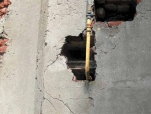The Rate of Cyclic Deterioration for Buildings

This article – is the final in the series of publications on the issue of natural and man-made high-cycle loads on buildings and structures. Previous articles published in the first and second issues of the “Tall Buildings Magazine” in 2011, were devoted to the topic of verification of phenomena cosmogenic evolution of the intensity of climatological, meteorological and geophysical processes, which at first glance, is far removed from the problems of the tall building construction.
However, the cyclical nature of these processes becomes critical in terms of design speed forecast for cyclical deterioration of building structures, especially tall buildings in a long and long-term periods of operation. Recently, for the maintenance of housing and communal services in operating and safe conditions, for example in Moscow in 2007, was spent at least 280 billion rubles of federal funds only. However, the prior technical inspection of buildings before reconstruction allows revealing only their current status.
Get the same reliable data to properly quantify the current and expected rate of depreciation of structures and degradation of geophysical stability of buildings in a short period of examination is not possible. In this regard, it is important not only research, valuation and forecast the evolution of the intensity of all types of natural and man-made cyclic loading on the project during the operation of buildings, but also development of methods for design modeling and their influence on the rate of deterioration of building structures.
The urgency of these problems in recent years has increased significantly due to global climate change and a sharp increase in the intensity of meteorological and geophysical processes in almost all urban areas of the planet. Along with this, in connection with the frequent accidents and the accelerated depreciation of buildings that were built on new technologies and with the application of new construction materials, greatly heightened the urgency of some fundamental problems in construction of high-cycle fatigue of building materials and soil foundation.
The peculiarity of the scientific formulation of these problems is connected with the lack of verified theoretical methods of design modeling and forecasting the intensity of the previously little-studied process of softening and wear of materials and structural elements of the constructions of complex shape and high heterogeneity of the spatial structure.
Existing methods of mathematical physics, as a rule, are successfully used for largely idealized problems of solid mechanics and structural mechanics, which by their essence are quite different from the actual workings of building structures. In connection with the expansion of research on the introduction of nanotechnology and nanomodified building materials in largescale production rose fundamentally new problems in nonlinear mechanics of solids.
Typically, such complex scientific problems of fundamental nature that are in the peripheral joints of different disciplines and areas (mathematical physics, nonlinear mechanics of rigid body, structural mechanics, nonlinear dynamics), can be successfully solved with the correct setting and shaping the necessary groundwork in terms of experimental studies.
With this methodological approach is formed by an extensive knowledge base about high-cycle loading and the experimental data on the previously little-known patterns and subtle nonlinear processes of high-cycle wear, which are characteristic to describe the actual work space building structures that were built from composite and anisotropic materials, as well as on–ground bases filled in within the estimated volume with diverse geological elements of complex shape and structure.
In this regard, the most important task of leading scientific schools and scholars of RAABS is a conduction of broad-based pilot studies to ensure effective progress in the development of fundamental methods for solving similar problems in construction and technology. Improving the climate and geological and geophysical stability of industrial and civil construction, residential buildings, basic facilities and life support systems, as well as minimizing the damage in regions with high levels of hydrological, meteorological and seismic risks are important factors for sustainable socio-economic development and national security of the Russian Federation.
Under the federal target program “Risk reduction and mitigation of natural and man-made disasters in the Russian Federation”, implemented measures aimed at improving the monitoring and forecasting of emergencies, including those due to climate and weather risks, seismic hazards and tsunami.
Full version you can download here
 TEXT VALERY TELICHENKO, CHANCELLOR OF MOSCOW STATE CONSTRUCTION UNIVERSITY (MSCU), PROFESSOR, ACADEMICIAN OF RAABS (RUSSIAN ACADEMY OF ARCHITECTURE AND BUILDING SCIENCE);
TEXT VALERY TELICHENKO, CHANCELLOR OF MOSCOW STATE CONSTRUCTION UNIVERSITY (MSCU), PROFESSOR, ACADEMICIAN OF RAABS (RUSSIAN ACADEMY OF ARCHITECTURE AND BUILDING SCIENCE);
ELENA KOROL,DR. TECH. SCIENCES, PROFESSOR, CORR. OF RAABS;
MICHAEL KHLYSTUNOV, PHD. TECH. SCIENCES, PROFESSOR, A HEAD OF AGCY OF RUSSIAN SPACE AGENCY SECTION OF MSCU;
JANNA MOGILYUK, HEAD OF A SECTOR OF RUSSIAN SPACE AGENCY SECTION OF MSCU


